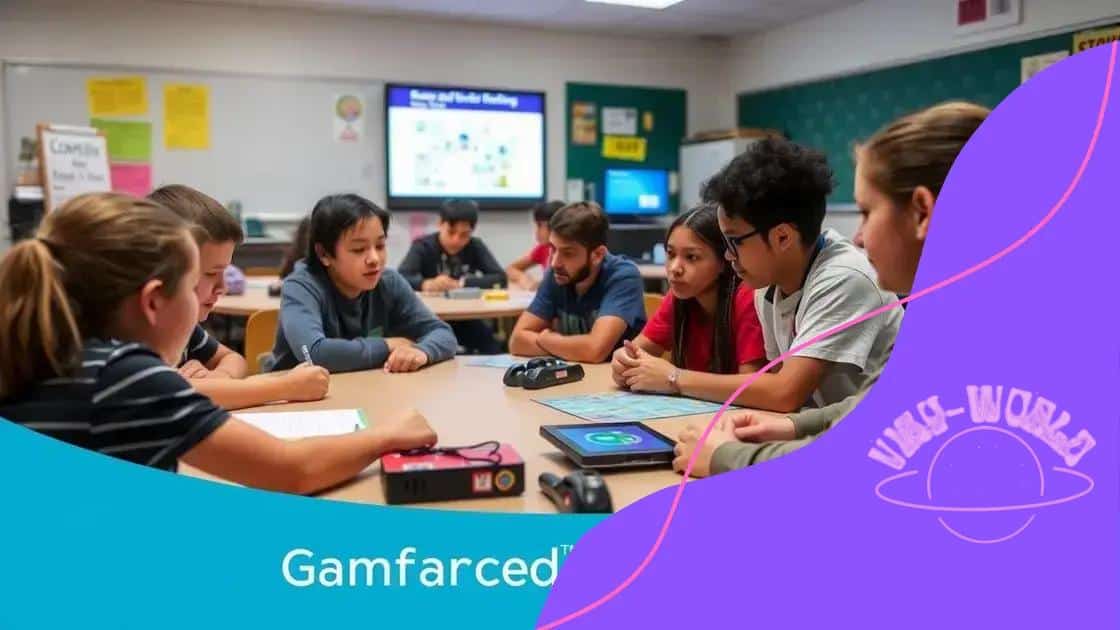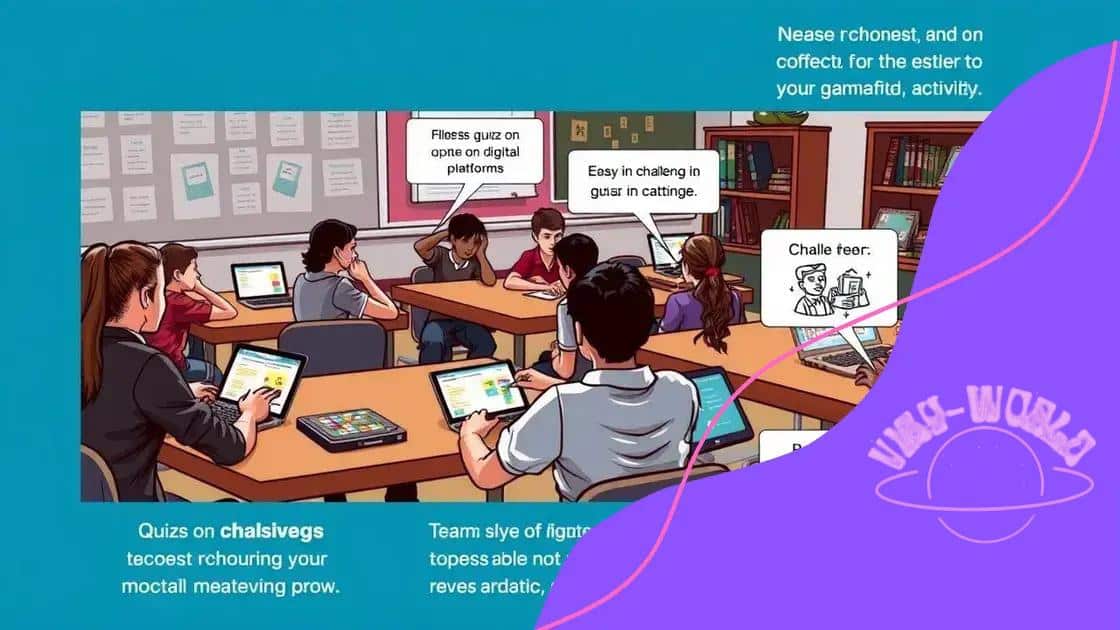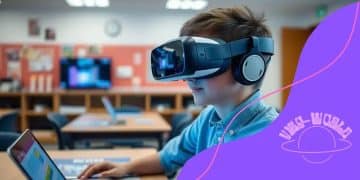Gamification in education: enhancing student engagement

Gamification in education enhances student engagement and motivation by using game-like elements, while future trends include virtual reality and personalized learning experiences to further improve learning outcomes.
Gamification in education is changing how students engage with learning materials. By incorporating game-like elements into the educational process, teachers can create a more interactive and enjoyable learning environment. Have you ever wondered how this method affects student participation?
Understanding gamification in education
Understanding gamification in education is essential for teachers and students alike. This innovative approach uses game design elements to enhance the learning experience. By applying these elements, educators can motivate students and create a more immersive atmosphere.
What is Gamification?
Gamification refers to the integration of game-like elements into non-game contexts, such as education. It combines the joy of playing with the structured learning framework. This method encourages participation and enthusiasm among students.
Key Components of Gamification
Several key components make gamification successful in an educational setting:
- Points systems that reward achievements.
- Leaderboards that foster healthy competition.
- Levels that indicate progression and mastery.
- Challenges that engage students in problem-solving.
By incorporating these elements, educators can enhance student motivation. For instance, when students earn points for completing assignments, they feel a sense of accomplishment. This can lead to improved performance and engagement in learning activities.
Moreover, gamified learning environments allow students to work at their own pace. They can revisit concepts as needed, reinforcing their understanding. This flexibility encourages self-directed learning, which is crucial in today’s fast-paced world.
As technology continues to evolve, gamification also embraces digital platforms. Online games can be used to teach various subjects, from math to literature. The interactive nature of these games makes learning both fun and educational.
Furthermore, gamification can cater to various learning styles. Visual learners may benefit from graphics and animations, while kinesthetic learners engage more with interactive elements. By recognizing these differences, teachers can create inclusive environments that support all students.
In summary, understanding gamification in education opens doors to enhanced learning experiences. Educators who implement this strategy can inspire more motivation, creativity, and a love for learning among their students.
Benefits of gamification for students
Benefits of gamification for students can greatly enhance the overall learning experience. When gamification is applied in education, it transforms how students interact with their lessons. Students become more engaged, actively participating in their own learning journeys.
Enhanced Motivation
One major benefit is the boost in motivation. Gamification incorporates rewards, such as points and badges, which can encourage students to strive for excellence. When they see their progress, it fuels their desire to learn. This encourages a growth mindset among students.
Improved Retention of Information
By making learning fun, gamification helps students remember what they learn. Engaging activities create memorable experiences. When students can visualize lessons through games, they are more likely to retain the information. This method helps transform tedious subjects into captivating challenges.
Collaboration and Social Skills
Another significant advantage is the promotion of collaboration. Many gamified activities require teamwork, leading to the development of essential social skills. Students learn to communicate, share responsibilities, and work towards a common goal.
- Encourages peer interaction.
- Fosters a sense of community.
- Enhances problem-solving abilities.
Furthermore, gamification allows for personalized learning experiences. Students can progress at their own pace, tailoring their education to fit their individual needs. Some may prefer to tackle challenging levels, while others might start with simpler tasks. This flexibility can enhance learning outcomes.
Gamification also caters to different learning styles. Visual learners can benefit from graphics, while hands-on learners engage more with interactive elements. By acknowledging these preferences, gamified environments create inclusive spaces that support all types of learners.
Ultimately, the benefits of gamification for students extend far beyond enjoyment. They include heightened motivation, improved retention of knowledge, and the development of crucial social skills. Educators who embrace this approach can foster a powerful learning atmosphere.
Practical examples of gamification in classrooms

Practical examples of gamification in classrooms showcase how teachers can apply game elements to enhance learning. These approaches can create an engaging atmosphere that motivates students to participate actively.
Classroom Challenges
One effective method is a classroom challenge, where students compete in teams to solve problems or complete tasks. For instance, teachers can set up a module on math problems. Each correct answer earns points for their team. This friendly competition encourages students to think critically and work together.
Digital Learning Platforms
Another popular example involves digital platforms that incorporate gamification. Tools like Kahoot! and Quizizz turn quizzes into exciting games. Students can join quizzes in real time and earn points based on their speed and accuracy. This not only makes learning fun but also provides instant feedback to the participants.
Role-Playing Games in History
Using role-playing games in history lessons is a creative way to engage students. By taking on the roles of historical figures, students can gain a deeper understanding of events. They can explore various perspectives and engage in discussions. This immersive experience makes history lessons memorable.
- Students can develop critical thinking skills.
- They learn collaboration through teamwork.
- Promotes empathy by understanding different perspectives.
Moreover, educators can introduce badges and rewards for achievements. For example, students can earn badges for completing projects or improving grades. This recognition motivates students to set goals and strive for excellence in their studies.
Incorporating storytelling into lessons can also be a fantastic way to gamify the classroom. Teachers can create narratives that tie into the curriculum, allowing students to embark on educational quests. This technique not only engages students but helps them relate to the material on a personal level.
Ultimately, practical examples of gamification in classrooms demonstrate the power of interactive learning. By utilizing these strategies, educators can create an environment that fosters enthusiasm, collaboration, and a love for learning.
Challenges of implementing gamification
Challenges of implementing gamification in education can hinder the effectiveness of this innovative approach. While gamification offers many benefits, it is essential to consider the obstacles educators might face when integrating it into the classroom.
Resource Limitations
One significant challenge is the availability of resources. Schools may lack the technology or tools needed to implement gamified activities fully. Not all teachers have access to digital platforms that support gamification, making it difficult to create engaging lesson plans.
Time Constraints
Time is another factor that can be problematic. Teachers often have packed curriculums and may struggle to find the time to incorporate gamification effectively. Designing games and activities takes additional time, which can be overwhelming for educators already managing multiple responsibilities.
- Limited time for lesson planning.
- Pressure to cover standardized material.
- Need for ongoing assessment and feedback.
Moreover, not all educators may feel comfortable with implementing gamification. Some might lack training or experience in using game mechanics in their teaching. This lack of confidence can lead to ineffective application and missed opportunities for engaging students.
Another challenge involves student variability. Different students might respond differently to gamification. While some students thrive in immersive learning environments, others may feel frustrated or disengaged, particularly if they struggle with the game mechanics or competition.
Additionally, gamification can sometimes lead to a focus on extrinsic rewards rather than intrinsic motivation. If students become too focused on earning points or badges, they may lose sight of the learning objectives. This shift can undermine the primary purpose of education, which is to foster understanding and curiosity.
In summary, while there are challenges in implementing gamification in classrooms, recognizing these obstacles can help educators develop strategies to address them. Training, resource allocation, and clear objectives can mitigate these challenges and enhance the gamified learning experience.
Future trends in gamification for learning
Future trends in gamification for learning are set to revolutionize education even further. As technology evolves, new opportunities for gamifying the learning experience continue to emerge. Understanding these trends can help educators stay ahead and engage students effectively.
Increased Use of Virtual Reality (VR)
One significant trend is the incorporation of virtual reality (VR) into gamified learning environments. VR offers immersive experiences that transport students into different worlds or scenarios. This technology can make complex subjects more relatable and engaging.
Personalized Learning Experiences
Another trend is the move towards personalized learning. Gamification will increasingly allow for customized educational pathways based on each student’s strengths and interests. By utilizing data, educators can tailor experiences that motivate individual learners.
- Dynamic difficulty adjustments based on student performance.
- Curated content that fits varying learning styles.
- Customization of goals to increase student agency.
Moreover, the integration of artificial intelligence (AI) will play a crucial role. AI can analyze student interactions to provide real-time feedback and suggestions. This adaptive learning approach helps educators identify areas where students may struggle and offers targeted support.
Social connections through gamification will also gain importance. Future gamified platforms may incorporate social networking elements, enabling students to collaborate and share achievements. This fosters a sense of community and teamwork among learners.
Focus on Skills Development
Another emerging trend is the emphasis on developing 21st-century skills. Gamified learning experiences will likely center on skills such as critical thinking, creativity, and problem-solving. Educators will design challenges that require students to apply these skills in real-world scenarios.
Mobile learning will continue to rise as well. As smartphones become ubiquitous, gamification will adapt to mobile platforms, providing access to learning anytime and anywhere. This flexibility encourages ongoing engagement and learning on the go.
In conclusion, the future of gamification in education promises to bring exciting innovations and changes. By incorporating new technologies and focusing on personalized, skill-based learning, educators can empower students and cultivate a love for learning.
FAQ – Frequently Asked Questions about Gamification in Education
What is gamification in education?
Gamification in education involves using game-like elements to enhance the learning experience, making it more engaging and interactive for students.
How can gamification improve student motivation?
Gamification can increase student motivation by incorporating rewards, challenges, and competition, encouraging students to participate actively in their learning.
What challenges might educators face when implementing gamification?
Challenges include resource limitations, time constraints, and varying student engagement levels, which can affect the effectiveness of gamified approaches.
What are some future trends in gamification for learning?
Future trends include increased use of virtual reality, personalized learning experiences, and a focus on developing 21st-century skills through gamified activities.





